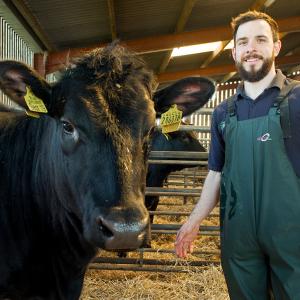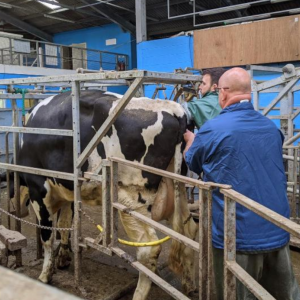
Paragon Advanced Breeding is now able to provide its Cow Stopper service to more farmers thanks to newly operational Embryo Transfer Technician Tom Redmayne.

Tom, whose family farm beef and dairy near Windermere, travelled the world working as a sheep shearer before spending the last three years learning Embryo Transfer.
Cow Stopper or repeat breeder embryos are an effective way of getting a cow to hold in calf, says Tom. But the service is not commonly available across the UK because it must be carried out by people qualified in Embryo Transfer.
“We are often booked up weeks in advance working on our other services and so it wasn’t always easy to fit in Cow Stoppers,” says Tom who joined the Paragon Advanced Breeding team at Newbiggin in 2018.
“Now that I am able to carry out Embryo Transfers it gives us more flexibility and means we can help more farmers with what is a fairly common problem,” he said.
Cow Stopper embryos are implanted into a cow a week after she has been served, and they help the establishment and recognition of pregnancy. Fifty per cent of cows given a Cow Stopper become pregnant, with most resulting calves being from the original insemination.
“We find that many farmers are not really aware that this option exists and that it is such an effective tool to use,” says Tom.
“It is mostly used in dairy. The costs of keeping a barren cow soon rack up and especially if you keep serving it.
“We see cows that have been served 10 or more times and have not been in calf for months. If you can get them in calf with one or two Cow Stoppers it is cost-effective.
“When the cow has a heat, we ask the farmer to AI it and seven days later we come out and implant an embryo. It is a straight-forward non-surgical procedure.”
Tom has learned how to transfer embryos working with Paragon’s Embryo Transfer Technician Mark Boland who has more than three decades’ experience in the technique.
Tom also gained a certificate in epidural anaesthesia from Liverpool University and took an AI course during his training period.
He lives at Southwaite where he, and his wife and son run a small holding.
Could ‘cow-stopper’ embryos be the solution?
What is a cow-stopper embryo?
It is not unusual for some cows to repeatedly fail to hold in calf and continue to return to oestrus every 21 days. Using a cow-stopper (repeat breeder) embryo could be an effective way to solve this problem. Cow-stopper embryos are transferred in to cows in addition to serving or artificially inseminating them. The addition of the cow-stopper embryo can help the establishment and recognition of pregnancy. An embryo (originally frozen at 7 days old) is thawed and implanted 7 days post oestrus/service. Matching the stage of cow-stopper embryo to the stage the cow is in her reproductive cycle is critical to improving conception rates.
Which cows require cow-stopper embryos?
Cow-stopper embryos are usually implanted in cows that have been served and/or artificially inseminated more than 3-4 times and have returned to oestrus or had a negative pregnancy diagnosis. Cow-stopper embryos are more commonly used in the dairy industry where there is the greatest need for a cow to produce a calf every year in order to continue milk production. Cow-stopper are sometime used in valuable beef cows that have proven difficult to get in calf.

How is the embryo implanted?
The day of implantation is 7 days after the cow has been served or artificially inseminated. The insertion of a cow-stopper is a non-surgical procedure. On the day an assessment of the repeat breeder cow’s ovaries will be made. As long as the cow has a corpus luteum (a small structure that is formed when the cow releases an egg of her own) on one of the ovaries, the cow-stopper can be implanted. The embryo is implanted using the standard technique used for embryo transfer. This involves using a fine catheter to allow the embryo to pass up through the uterus and in to the uterine horn. The procedure is carried out under epidural anaesthesia to prevent discomfort for the cow. The cow-stopper can be put in on natural or synchronised heat.
Results from cow-stopper embryos?
Cow stoppers used in a dairy herd are normally easy calving beef breed embryos, making identification of the resulting calf easy.
Are cow-stoppers for me?
Often farmers are surprised at how cost effective the cow-stopper service is, especially when the price is compared to the expense of keeping an unproductive barren cow or replacement.
For more information regarding cow-stopper embryos please get in touch with Paragon Veterinary Group: 01768 483789